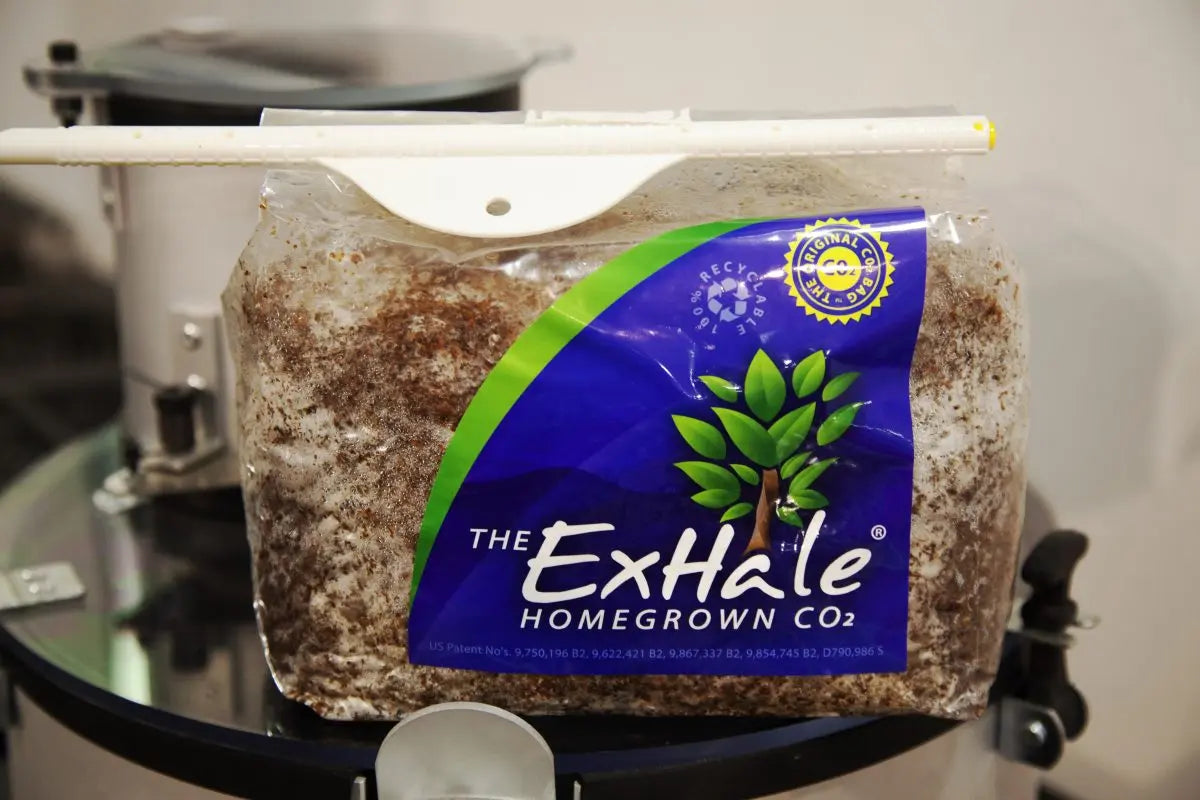In our last article to do with CO2 supplementation, we concluded that it definitely made a significant difference to plant growth. In this post, we go into the nitty-gritty of what equipment is involved and how to use it in a grow-space. There are various different ways to increase the CO2 levels of a grow environment, and they range from the cheap and cheerful right the way through to equipment that controls not only CO2 levels, but also the other environmental air factor (temperature, humidity) that can affect a grow. This type of equipment represents an investment that will pay considerable dividends in terms of yield increases.
The Exhale Homegrown CO2 Mycelium Grow Bag
One of the easiest products to use to supplement the C02 in your grow-space is the Exhale Homegrown CO2 Mycelium Grow Bag. This bag contains a mixture of dormant fungal mycelium mixed with a rich source of food for it. The bags remain dormant when stored in cool & dark conditions. Once the bag has been hung in the bright, warm conditions of a grow tent, or other grow area, the mycelium will begin to actively grow, releasing CO2 as a side-effect. The CO2 flows out of the breather patch near the top of the bag and then enriches the surrounding air. CO2 is actually heavier than air, and will tend to sink towards the floor. For this reason, the Grow Bag is best hung at least a little above the top of the plant canopy, To further improve the effectiveness of the Grow Bag is to have a circulation fan nearby to mix the released CO2 into the air. The contents of the Grow Bag provides CO2 for about six months. During this time the contents gradually change colour from a cream and white mix to a brown-black. After the six months, the bag needs to be changed out for a fresh one.
This product produces CO2 in the same way as the mycelium grow bag above. The bucket contains a bigger volume of mycelium and food mix and so it produces CO2 at a faster rate than the mycelium grow bag. The large bucket would be very inconvenient to hang in a grow space, so an air pump and airline is provided to transport the produced CO2 to just above the canopy. The bucket can then be placed in a much more convenient position on the floor or on a shelf.
A CO2 enrichment system based on mycelium is certainly a lot more convenient and less messy than any diy bicarbonate of soda and vinegar drip device, or yeast-based production. It will definitely enhance your grow. However, if you want to go to the next level and really optimise CO2 levels then you need to consider a system based on CO2 release from a bottle. Ecotechnics make a CO2 controller that controls a CO2 bottle valve (regulator) and your extraction system. You dial in the size of your grow-space in cubic metres, the desired CO2 concentration in ppm (1000 to 1500 ppm is usually an optimal level). Also dial in the lower desired limit in ppm. It detects when the lights go out and stops releasing CO2 (this is because plants only require CO2 while they are photosynthesising - ie when the lights are on). An Ecotechnics CO2 Analyser can also be connected to the set up to get the CO2 levels perfect. Adding the analyser will tell the controller exactly what the current CO2 levels are. The controller then releases CO2 to maintain the levels you programmed into it.
Dimlux are best known for their pro-type HPS grow-lights that rival Gavita's. However they also make a CO2 Controller, Regulator and Sensor similar to those made by Ecotechnics. A huge additional benefit with the Dimlux system is that the controller can also control up to 160 of their professional lights.
Not only that, but with the addition of an add-on Humidity Sensor and add-on Temperature Sensor or Plant Temperature Camera will also allow the Controller to dim the lights to reduce the grow-room temperature as needed to keep something called the "Vapour Pressure Deficit" (or VPD) in the perfect range. VPD is a bit beyond the scope of this particular article but I will be devoting an entire blog article about it in the near future. However, suffice it to say that getting the VPD in the right range in your grow-space is quite simply the Holy Grail in terms of providing your plants with the ideal grow environment. It is all about getting the relative levels of temperature and humidity spot-on so that your plants can photosynthesise and grow optimally, and avoid situations that would allow mould to grow. Superb!

